SAP HR Tutorial
Overview, Introduction to SAP HR: What is SAP HR?
SAP Human Resources (HR) serves primarily to manage tasks related to staff such as payroll, time & attendance tracking, benefits administration and personnel administration.

SAP HR makes life simpler for HR managers by helping them efficiently administer various administrative duties ranging from recruiting new staff members to terminating existing ones.
Monitoring an employee’s income, training and development, performance appraisal and appraisal reviews, health & safety, employee benefits administration, travel expense reports as well as performing other administrative duties is the responsibility of management.

SAP HR system helps businesses manage the various stages of employee lifecycle – from recruitment and onboarding through attrition – efficiently, significantly cutting time and cost associated with manual HR processes.
SAP HR definition OR Define SAP HR
SAP Human Resources (HR) provides commercial enterprises with an efficient means to centrally store, coordinate and consolidate employee data this functionality being offered by SAP itself.
Organisations gain access to all the data they require in an organized and timely fashion for performing timely analyses on employee personnel data and keeping an accurate record.
SAP HR provides an impressive variety of workforce management capabilities.
Some examples are employee demographics, absence tracking and tracking expensesas well as salary informationcareer development planningorganisational administration management capabilities and organisational oversight capabilities.
SAP Enterprise Resource Planning (ERP) includes SAP HR as one of its modules companies all around the globe leverage it for better control over human resources procedures and to unlock employees’ true potential.
As HR professionals, our primary responsibility lies with recruiting and onboarding new employees as well as overseeing employee data, creating payrolls in a timely and correct fashion, offering benefits packages to employees, monitoring performance reviews and administering compensation schemes.
What exactly does SAP HR accomplish and what are some of the applications for SAP HR?
SAP ERP (Enterprise Resource Planning) features SAP HR (Human Resources), providing businesses with an all-in-one HR management solution.
Automating day-to-day HR processes like recruitment, performance evaluation and personnel administration as well as time tracking, payroll processing and attendance reporting provides considerable efficiencies and reduces administrative workload for HR administrators.

SAP HR provides an array of tools for the management of organizational structures, talent development and human cost planning.
Recruitment and Onboarding: SAP HR provides businesses with assistance for recruiting potential employees by creating job listings and reviewing resumes; further, onboarding newly employed staff members is made simpler with employee profiles created through this solution.
Organizational Structure Management: SAP HR allows businesses to set up, administer and track organizational hierarchies, job functions and positions within an organisational hierarchy.
Accurate Tracking of Time and Attendance SAP HR empowers businesses with accurate time tracking capabilities that reliably log attendance data, process leave requests, record absences or tardiness and manage leave requests.
Performance and Career Management: SAP HR’s platform can assist in handling performance reviews, outlining career plans, managing personnel effectively and planning for succession.
Payroll and benefits administration With SAP HR’s single platform approach for payroll and employee benefits administration, businesses are able to save considerable time.
Reporting and analytics: SAP HR provide reports designed to analyse employee information such as headcount, turnover rate and HR costs.
How does SAP HR work
SAP HR stands for Human Resources software that allows businesses to efficiently and cost-effectively manage personnel activities through effective human resource software systems. It aims to do just this!
Keep a comprehensive record of employee information such as employment history, compensation details, medical benefits and vacation days.
Additionally, it can integrate with programs designed to manage payroll, automate recruitment procedures and analyse staffing-related data.
SAP HR provides efficient HR activities management across an organisation and has even proven capable of being integrated with various other IT network components, including financial accounting management systems and customer relationship management applications.

Why should we use SAP HR, and what are the advantages of using SAP HR?
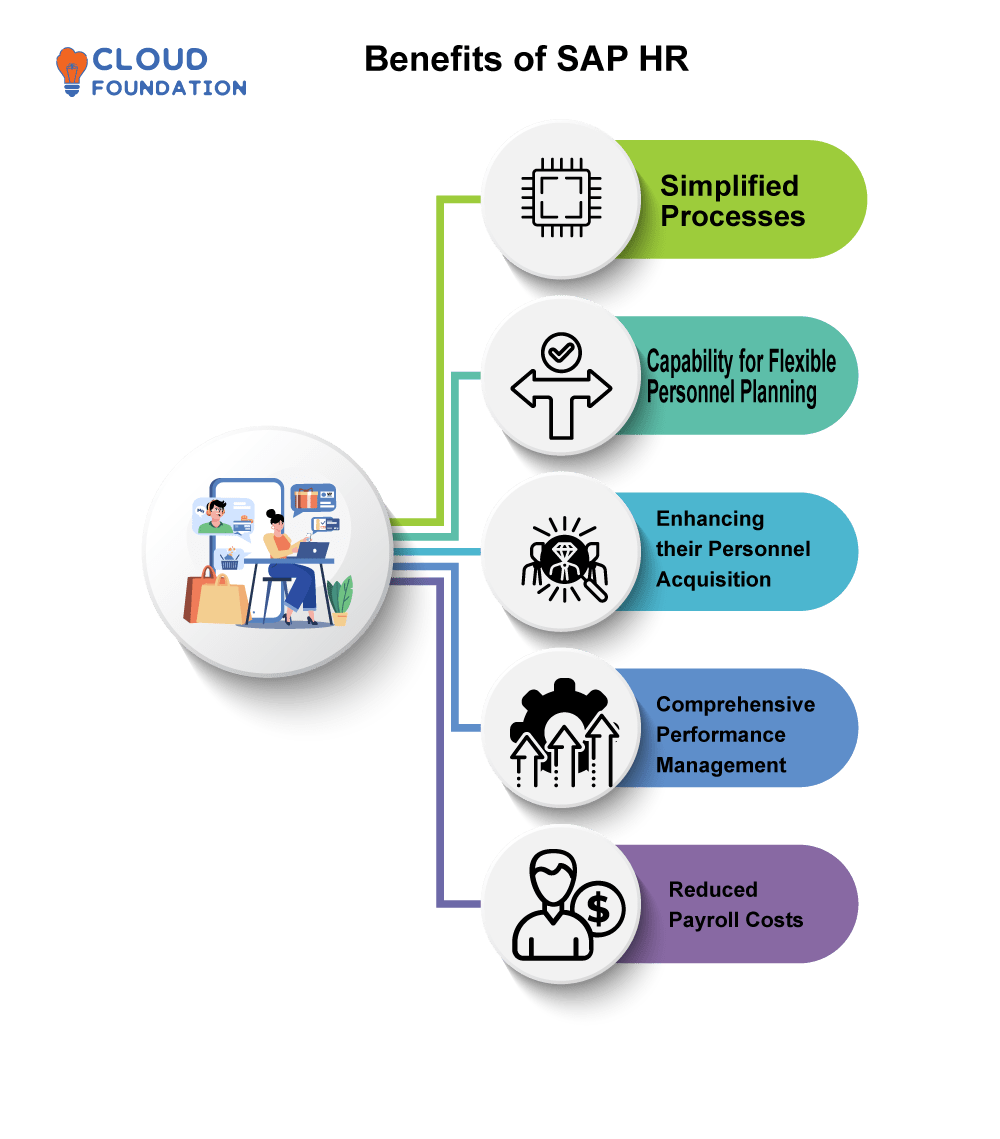
SAP HR (Human Resources) is an integrated Human Capital Management (HCM) system designed to help businesses identify, recruit and retain talented workers while decreasing turnover rates and employee attrition rates.
Employee data management solutions encompass apps and services used for employee tracking, payroll processing, recruitment/training of new recruits/trainees/absenteeism reporting/vacation time tracking as well as benefits administration/organisational structure support.
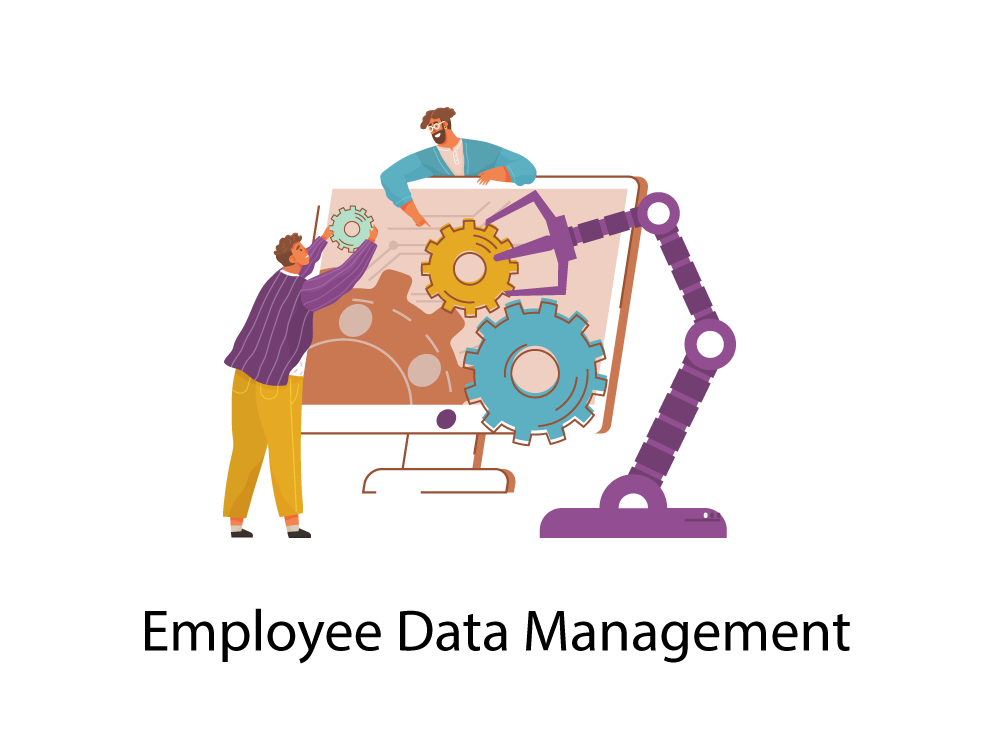
SAP HR offers businesses a consolidated platform to streamline essential HR activities, optimise recruitment cycles and reduce training expenses as well as foster employee engagement and enhance company performance.
Here is a brief outline of some benefits associated with SAP HR:
Simplified Processes and Improved Employee Information Management: SAP HR simplifies procedures while increasing employee information management efficiency, making it possible to more easily track employee data while protecting current records.
This improves operational efficiencies by eliminating paperwork burden and making employee development easily trackable in real-time.
Capability for Flexible Personnel Planning: SAP HR’s flexible personnel planning solution can assist managers in making more informed decisions by offering information such as skill sets, individual performance statistics and company goals – providing essential assistance with future planning capabilities.
Enhancing their personnel acquisition: With recruitment processes simplified and recruitment strategies improved, organisations are better able to quickly find and hire suitable talent for every position available within their organisation.
Comprehensive Performance Management: SAP HR offers an innovative performance management system designed to assist companies in evaluating employee performances and pinpointing areas for improvement.
Once performance data are analysed, this information can then be utilized as a source for developing personalized development plans with goals of increasing job-specific skills while creating staff who are both highly productive and actively engaged with their work environment.
Reduced Payroll Costs: SAP HR offers businesses an automated payroll system which can significantly decrease payroll-related costs.
By eliminating paperwork and speeding up payroll processing, this technology makes managing employee wages much simpler for companies.
Advantages of SAP HR
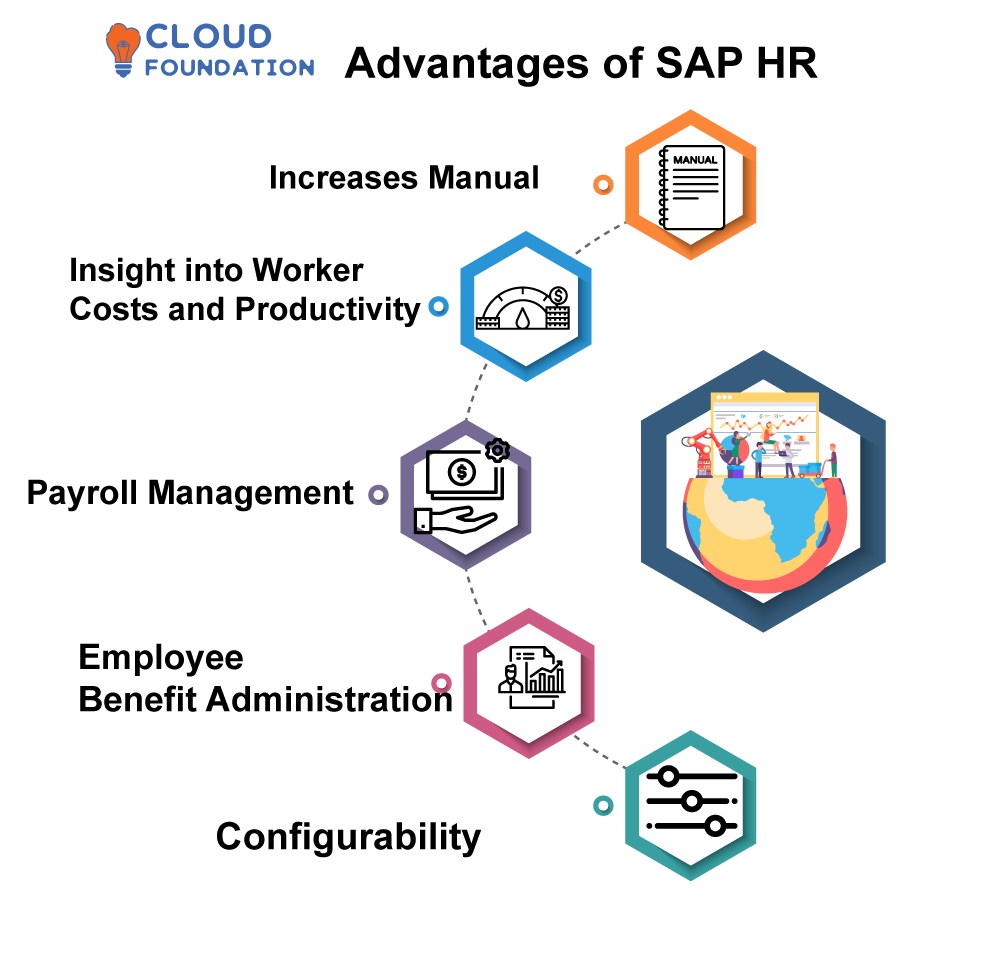
SAP HR streamlines HR procedures and increases manual HR productivity with its automated processes for employee recruiting, applicant screening and performance reviews as well as training & development programs – giving HR employees more time for tasks which are strategic or important for business operations.
It Provides Insight into Worker Costs and Productivity: SAP HR provides real-time data that may assist businesses in making more informed decisions regarding hiring, staffing and performance management of employees.
This may enable better informed hiring, staffing and performance monitoring decisions to be made more accurately by businesses using this resource.
It Assists with Payroll Management: With SAP HR integrated with payroll, managing all aspects of pay-roll is made much simpler – computation of wages and taxes due, deductions from wages etc.
It Simplifies Employee Benefit Administration: SAP HR makes managing employee benefits such as health, disability and retirement programs simpler for administrators.
Its High Configurability SAP HR offers great customization potential that enables it to adapt easily to meet the individual requirements of an organisation.
What is SAP HR software and how to use SAP HR
SAP Human Capital Resources software enables organisations to effectively manage their personnel as part of SAP ERP, with reporting and analytics included for reporting purposes as well as regulatory compliance while controlling labour expenses and productivity trends.
Originally introduced with R/3 back in 1992 and currently included as an offering in S/4HANA.
SAP HR requires professional installation. An SAP-accredited partner assists with this step.
Once SAP HR is operational, users may log in, establish accounts and enter data into modules such as Personnel Development to monitor employee performance
HR Master Data holds personnel data while Time & Attendance offers time tracking features to keep an eye on vacation days, overtime work and attendance schedules.
Users of SAP HR are able to export and analyse the data entered, or produce reports for their organization after entering it.
SAP offers various user-friendly services – online forums and tutorials – in order to help optimize this system for each individual user.
SAP HR tool
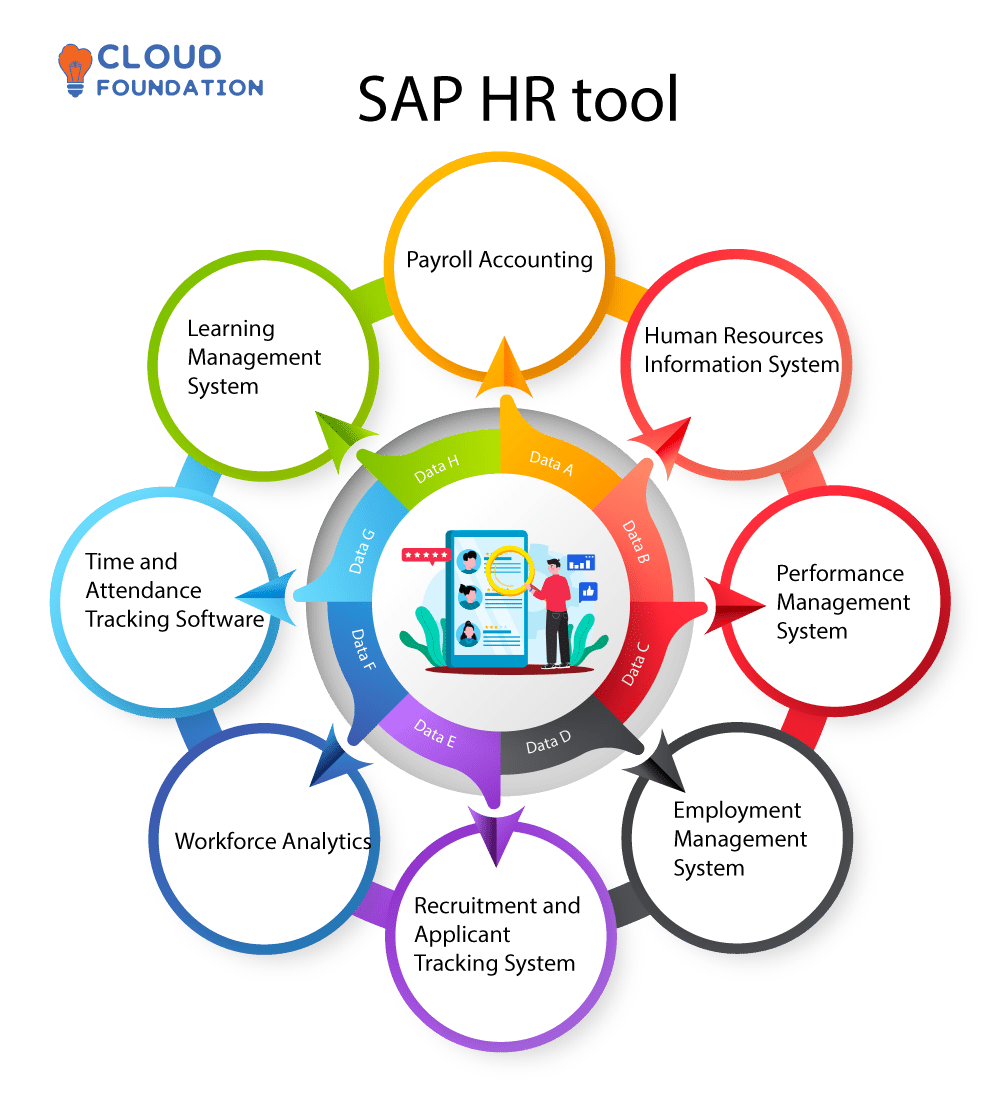
Payroll Accounting: With this software, users have the capability of monitoring, recording and computing employee salaries in real-time.
Furthermore, it updates, validates and automates this information for increased efficiency when processing salaries.
Human Resources Information System (HRIS): HRIS is a database used for keeping track of employee records, helping speed the recruitment and hiring processes as well as benefits administration and performance monitoring.
Learning Management System (LMS): LMS software assists in organizing and tracking training activities as well as in the creation and delivery of online courses as part of accreditation requirements.
Time and Attendance Tracking Software: Time and Attendance Tracking software assists companies in keeping an accurate count of employee working hours as well as any absences, vacation time taken off work and overtime pay accrued by each worker.
Furthermore, paid time off entitlement can also be managed efficiently via this application.
Workforce Analytics: Workforce analytics provide organisations with insight into their workforce statistics such as staff turnover, skill levels, job satisfaction levels and other various analytics.
Recruitment and Applicant Tracking System (ATS): This tool assists in automating the recruitment process from job posting, screening of applicants, interview scheduling and conducting of interviews to streamlining employment processes that reduce hiring costs.
Employment Management System (EMS): This type of system helps manage all stages of an employee lifecycle from recruitment through retirement, making the hiring, onboarding, payroll administration, performance evaluation and benefits administration processes simpler to administer.
Performance Management System (PMS): Companies using this application to track and improve employee performance use other apps like job analysis, goal planning and performance reviews to accomplish this task.
SAP HR modules
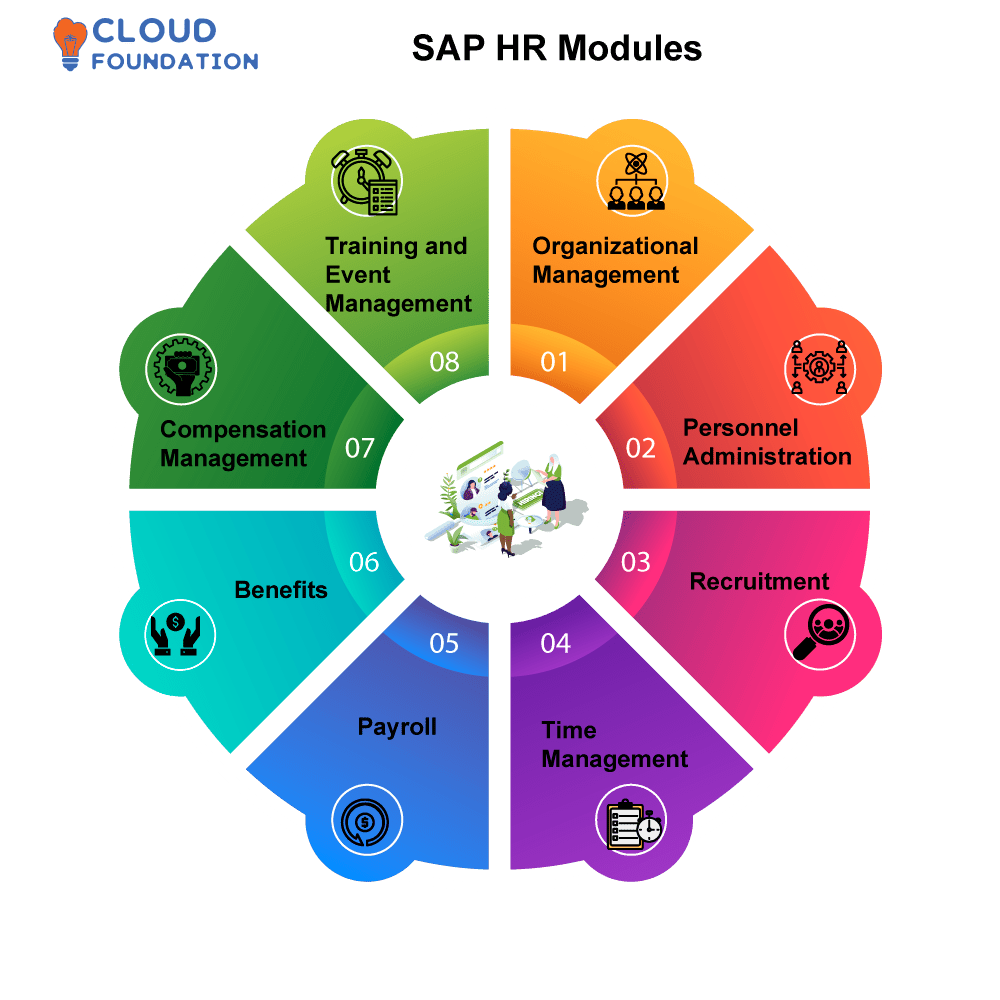
Organizational Management: This feature of SAP HR modules permits the user to set and oversee the organizational structure of a business, while tracking positions and objects created within it to assess relationships among them.
Personnel Administration– This feature makes managing personnel information in your system simpler, including personal details like contact info and benefits details for all staff.
Recruitment allows users to easily search candidates, post positions and select candidates while also tracking progress of recruitment processes.
Time Management – Time management keeps digital records for time accounting on both an individual or organisational level, helping the user plan holidays, leaves and overtime work accordingly. This feature can be utilized by both individuals and organisations alike.
Payroll is a comprehensive function, including features for taxation, salary increments, income taxes and deductions calculation and more.
Benefits – This feature assists users in the processing of benefits related to medical, retirement, housing or any other related benefits.
Compensation Management provides users with the tools needed to organize employee compensation packages and to calculate compensations according to those packages.
Training and Event Management: With this feature, a user is given the power to efficiently organize training events held for employees as well as keep a record of all courses taken and their completion statuses.
Where can I get the most out of my SAP HR?
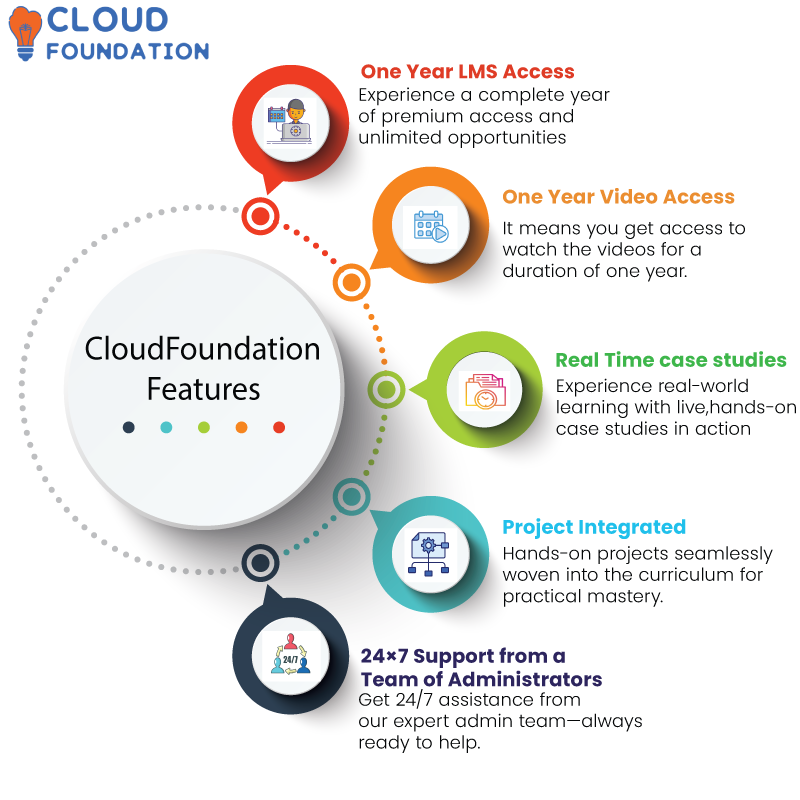
Obtain Training in CloudFoundation, they offer Course for SAP HCM for Beginners and experienced which allow participants to learn its fundamentals efficiently in an organized setting allowing more in-depth knowledge acquisition on how to use this software application in order for maximum productivity!
Read Books about SAP HR You can purchase books about SAP HR that provide further insight. Furthermore, participating in workshops regarding this field could lead to further certification on it.
Put Your Knowledge into Practice: Applying your knowledge of SAP HR will allow you to expand it further in a real-world setting. There are various options for purchasing or using the free trial version of the programme in order to gain hands-on experience with it.
Join Online Communities There are various SAP HR forums and groups online; participating can be an excellent way to communicate with others who use SAP HR while benefiting from information shared from long-time members who can share insights.
Attend SAP Conferences: Attending SAP conferences gives attendees an unparalleled opportunity to network with fellow SAP professionals while also expanding your knowledge on SAP HR’s recommended practices, product updates and any technical advances that have emerged since previous conferences were hosted.

Shreshtha
Author



